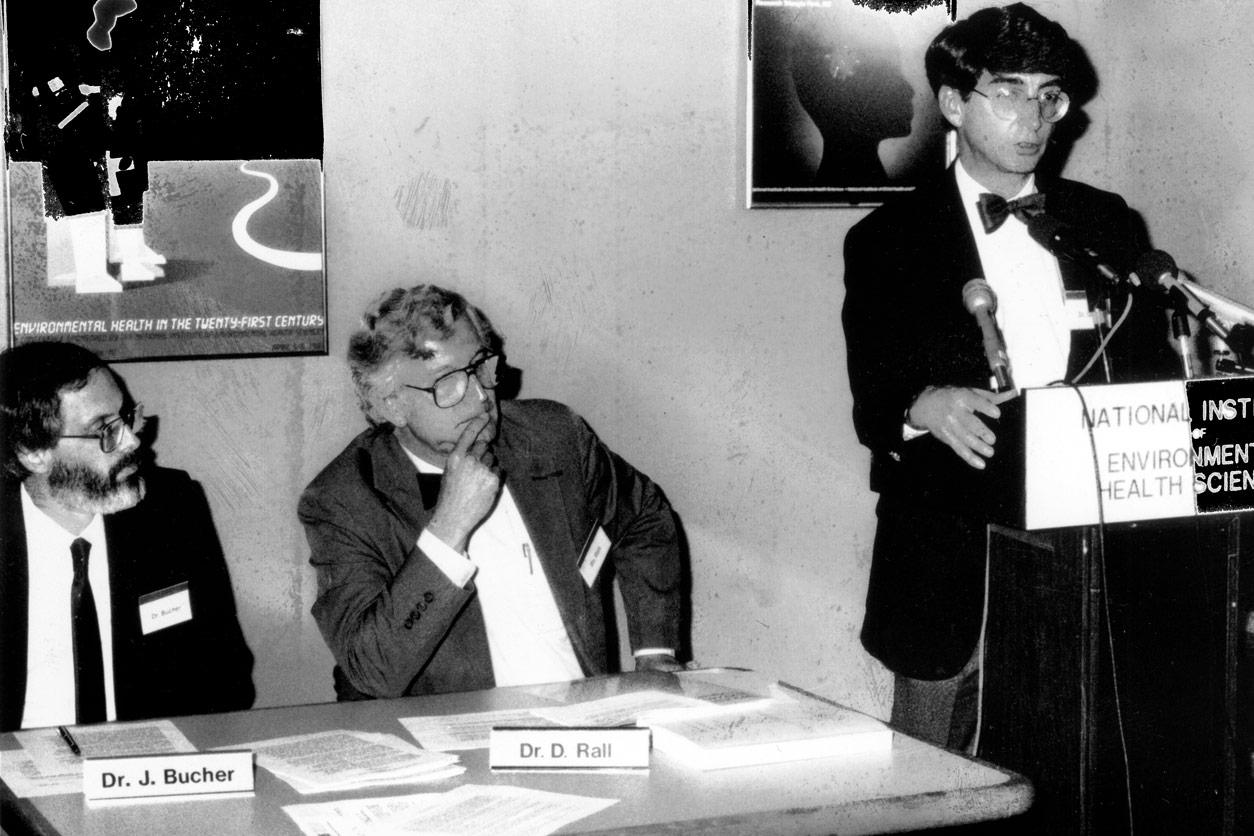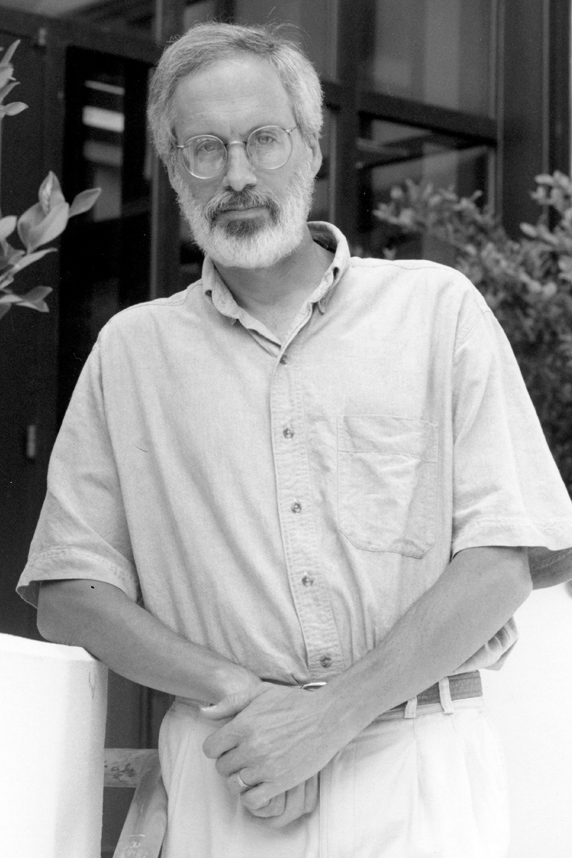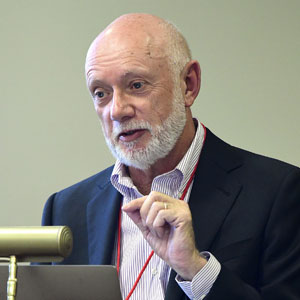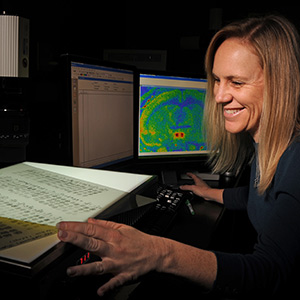John Bucher, Ph.D., senior scientist in the NIEHS Division of the National Toxicology Program (DNTP), retired in April after nearly four decades at the institute. His scientific achievements, innovative thinking, and mentorship will leave a lasting influence, according to colleagues.
Throughout his career, Bucher advanced knowledge on the health effects of numerous environmental agents, such as fluoride and cell phone radiation. He also expanded understanding and adoption of nonanimal approaches to toxicological research.
 Bucher, shown above in 2014, regularly reported to the NTP Board of Scientific Counselors. (Photo courtesy of Steve McCaw / NIEHS)
Bucher, shown above in 2014, regularly reported to the NTP Board of Scientific Counselors. (Photo courtesy of Steve McCaw / NIEHS)Reducing use of animals
After earning his undergraduate degree in biology from Knox College in Illinois, Bucher received a master’s in biochemistry from the University of North Carolina at Chapel Hill. He then took up pharmacology as a doctoral student at the University of Iowa.
Later, Bucher drew insights from pharmacology when developing ways to reduce the use of animals in toxicological research and study chemicals more rapidly and efficiently. He said that his achievements in this regard are especially rewarding.
“Traditional toxicology studies often are too expensive and time-consuming, and it can take years for findings to be disseminated,” said Bucher. “I am proud that my colleagues and I recognized that this was unsustainable and worked to advance novel experimental approaches.”
 In 1991, Bucher, left, helped NTP announce its fluoride review, with former NIEHS and NTP Director David Rall, M.D., Ph.D., center; and Mike Gallo, Ph.D., former NTP Board of Scientific Counselors chair. (Photo courtesy of NIEHS)
In 1991, Bucher, left, helped NTP announce its fluoride review, with former NIEHS and NTP Director David Rall, M.D., Ph.D., center; and Mike Gallo, Ph.D., former NTP Board of Scientific Counselors chair. (Photo courtesy of NIEHS)Intellectual influence
In the early 2000s, Bucher brought his leadership to bear by promoting such approaches in contributions to a strategic roadmap for the National Toxicology Program(https://ntp.niehs.nih.gov/) (NTP). “John brought bold thinking to the field, and he played a pivotal role in transitioning toxicology to a more predictive science,” noted NIEHS and NTP Director Rick Woychik, Ph.D.
“We wanted to identify potential human health hazards from a wide array of chemicals by means of high-throughput screening, using robotics and associated bioinformatic technologies,” Bucher explained.
That new focus represented a paradigm shift in toxicology, and it was a significant influence on a major 2007 report by the National Research Council titled “Toxicity Testing in the 21st Century: A Vision and a Strategy.” The publication led to a federal partnership still in place today.
Collaborators include researchers from DNTP, the National Human Genome Research Institute, the U.S. Environmental Protection Agency, and the U.S. Food and Drug Administration (FDA). More information on this joint effort, called Tox21(https://ntp.niehs.nih.gov/whatwestudy/tox21/), is available.
 Bucher spoke with Mary Wolfe, Ph.D., DNTP acting deputy director for policy and communication, during the July 2017 peer review of NTP technical reports. (Photo courtesy of Steve McCaw / NIEHS)
Bucher spoke with Mary Wolfe, Ph.D., DNTP acting deputy director for policy and communication, during the July 2017 peer review of NTP technical reports. (Photo courtesy of Steve McCaw / NIEHS)Leadership at NIEHS, NTP
Bucher joined NIEHS as a staff toxicologist in 1983, eventually rising to leadership positions. He became associate director of NTP in 2007. Bucher worked with former NIEHS and NTP Director Linda Birnbaum, Ph.D., to transition the institute’s NTP-related efforts into an intramural research unit, DNTP. He became the DNTP scientific director in 2011.
“John was an amazing, steady force at NIEHS and NTP,” said Birnbaum. “In his quiet way, he moved the science forward, and his retirement leaves a huge hole.”
Some of Bucher’s other contributions and achievements are listed below (see second sidebar for more highlights). He emphasized that all were collaborative efforts.
 Portrait of Bucher, taken in the 1990s. (Photo courtesy of NIEHS)
Portrait of Bucher, taken in the 1990s. (Photo courtesy of NIEHS)- Facilitated formation of Interagency Coordinating Committee for the Validation of Alternative Methods(https://ntp.niehs.nih.gov/whatwestudy/niceatm/iccvam/) and the Office of Health Assessment and Translation.
- Fostered development and adoption of systematic review methods for assessing environmental health literature.
- Coordinated research responses to chemical spill in West Virginia’s Elk River, at request of U.S. Senator Joe Manchin, and methyl isocyanate gas poisoning incident in Bhopal, India, at request of U.S. Department of State.
His mentorship mattered
Nigel Walker, Ph.D., from DNTP, said Bucher oversaw studies of a variety of exposures while at NIEHS, ranging from acrylamide to zinc. “He literally covered it all, from A to Z,” joked Walker.
“For 10 years as his deputy, I had the good fortune of seeing John operate up close,” he continued. “John was instrumental in helping me and many others get to where we are today. He challenged us and afforded us opportunities where we had to step up to the plate to solve complex problems.
“Due to John’s leadership, the NTP brand is looked upon globally as the gold standard in toxicological research. We wish him a wonderful retirement.”
(Jesse Saffron, J.D., is a media relations coordinator in the NIEHS Office of Communications and Public Liaison.)
Check out these papers for more detail on Bucher’s research and ideas. — Ed.
Gwinn WM, Auerbach SS, Parham F, Stout MD, Waidyanatha S, Mutlu E, Collins B, Paules RS, Merrick BA, Ferguson S, Ramaiahgari S, Bucher JR, Sparrow B, Toy H, Gorospe J, Machesky N, Shah RR, Balik-Meisner MR, Mav D, Phadke DP, Roberts G, DeVito MJ. 2020. Evaluation of 5-day in vivo rat liver and kidney with high-throughput transcriptomics for estimating benchmark doses of apical outcomes. Toxicol Sci 176(2):343–354.
Ginsberg GL, Pullen Fedinick K, Solomon GM, Elliott KC, Vandenberg JJ, Barone S Jr, Bucher JR. 2019. New toxicology tools and the emerging paradigm shift in environmental health decision-making. Environ Health Perspect 127(12):125002.
Rooney AA, Boyles AL, Wolfe MS, Bucher JR, Thayer KA. 2014. Systematic review and evidence integration for literature-based environmental health science assessments. Environ Health Perspect 122(7):711–718.
Tice RR, Austin CP, Kavlock RJ, Bucher JR. 2013. Improving the human hazard characterization of chemicals: a Tox21 update. Environ Health Perspect 121(7):756–765.
Walker NJ, Bucher JR. 2009. A 21st century paradigm for evaluating the health hazards of nanoscale materials? Toxicol Sci 110(2):251–254.
Collins FS, Gray GM, Bucher JR. 2008. Toxicology. Transforming environmental health protection. Science 319(5865):906–907.
Bucher JR. 1987. Methyl isocyanate: a review of health effects research since Bhopal. Fundam Appl Toxicol 9(3):367–379.









